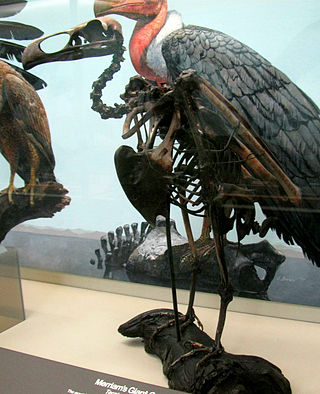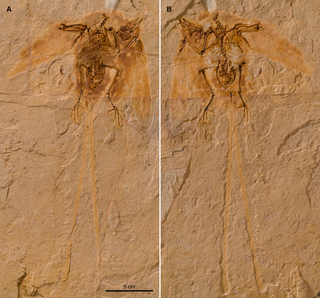
Old World vultures are vultures that are found in the Old World, i.e. the continents of Europe, Asia and Africa, and which belong to the family Accipitridae, which also includes eagles, buzzards, kites, and hawks.

The cinereous vulture is a large raptor in the family Accipitridae and distributed through much of temperate Eurasia. It is also known as the black vulture, monk vulture and Eurasian black vulture. With a body length of 1.2 m, 3.1 m (10 ft) across the wings and a maximum weight of 14 kg (31 lb), it is the largest Old World vulture and largest member of the Accipitridae family.

Teratornithidae is an extinct family of very large birds of prey that lived in North and South America from the Late Oligocene to Late Pleistocene. They include some of the largest known flying birds. Its members are known as teratorns.
Largirostrornis is a genus of enantiornithean bird. One species has been named, Largirostornis sexdentoris. It lived during the Early Cretaceous and is known from fossils found in the Jiufotang Formation in Liaoning province, People's Republic of China. Some researchers believe this species to be a junior synonym of the similar Cathayornis yandica.
Paleontology or palaeontology is the study of prehistoric life forms on Earth through the examination of plant and animal fossils. This includes the study of body fossils, tracks (ichnites), burrows, cast-off parts, fossilised feces (coprolites), palynomorphs and chemical residues. Because humans have encountered fossils for millennia, paleontology has a long history both before and after becoming formalized as a science. This article records significant discoveries and events related to paleontology that occurred or were published in the year 1993.
Paraprotopteryx is a genus of enantiornithean birds from the Mesozoic of China.
Jibeinia is a genus of enantiornithean bird. Only one species has been named, Jibeinia luanhera. It is known from one holotype fossil found in the Hebei province, People's Republic of China. This fossil is now lost. The holotype was, however, described and figured in detail by Hou (1997).
Huoshanornis is a genus of enantiornithine birds which existed in what is now Jiufotang Formation of Western Liaoning Province, China during the early Cretaceous period. Its fossil remains were found at Chaoyang City. It was first named by Xia Wang, Zihui Zhang, Chunling Gao, Lianhai Hou, Qingjin Meng and Jinyuan Liu in 2010 and the type species is Huoshanornis huji.
The year 2012 in Archosaur paleontology was eventful. Archosaurs include the only living dinosaur group — birds — and the reptile crocodilians, plus all extinct dinosaurs, extinct crocodilian relatives, and pterosaurs. Archosaur palaeontology is the scientific study of those animals, especially as they existed before the Holocene Epoch began about 11,700 years ago. The year 2012 in paleontology included various significant developments regarding archosaurs.

Neogyps is an extinct monotypic genus of Old World vulture. Despite being an "Old World" vulture taxonomically, it was native to the New World, with its fossils having been found in western North America, including in the La Brea Tar Pits of southern California, dating to the Late Pleistocene. Several morphological characters suggest that Neogyps is closely related to the subfamily Gypaetinae.

Neophrontops is an extinct genus of Old World vulture. Despite being taxonomically an "Old World" vulture, specifically a member of the subfamily Gypaetinae, it was native to North America, with six species having been named, spanning from the Early Miocene to the Late Pleistocene. All except N. americanus are only known from fragmentary remains, though well preserved remains are known from the late Middle-Late Pleistocene aged La Brea Tar Pits of Southern California.
Leptoptilos patagonicus is an extinct species of large-bodied Leptoptilini stork that existed during the Late Miocene. Fossils of the species were discovered in the San Madryn Formation in Chubut Province, Argentina. L. patagonicus is the first fossil record discovery of a member of Leptoptilos in South America and the only one found so far in the New World.
Leptoptilos lui is an extinct species of large-bodied Leptoptilini stork that existed during the Middle Pleistocene. Along with Aegypius jinniushanensis, L. lui is one of several new species of extinct birds discovered at Jinniushan, Liaoning, China. The extinct stork is named after Professor Zun-e Lu.
Jinniushan is a Middle Pleistocene paleoanthropological site, dating to around 260,000 BP, most famous for its archaic hominin fossils. The site is located near Yingkou, Liaoning, China. Several new species of extinct birds were also discovered at the site.
Aegypius prepyrenaicus is an extinct Old World vulture which existed in what is now Spain during the Middle Pleistocene period. An ulna possibly referable to this species has been found in Gibraltar. It was described in 2001 by Hernandez Carrasquilla.

Junornis is a bird genus, belonging to the Enantiornithes, that during the Early Cretaceous lived in the area of present China.
Guanyindong or Guanyin Cave is a Palaeolithic cave site, discovered in 1964 by archaeologist Pei Wenzhong in Qianxi County, Guizhou, China.

The Liushu Formation is a geological formation in Gansu province, China that spans up to 100 m thick and is widely distributed within the Linxia Basin, with a paleomagnetic age between 11 and 6.4 mya.






